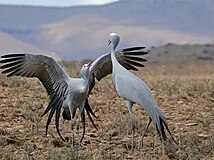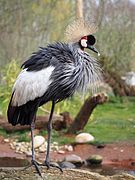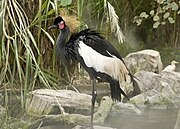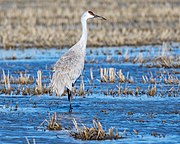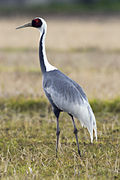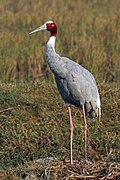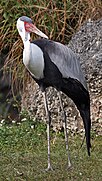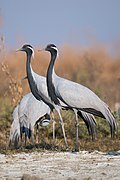List of cranes
Cranesare tallwading birdsin thefamilyGruidae. Cranes are found on every continent except for South America and Antarctica and inhabit a variety of open habitats, although most species prefer to live near water.[1]They are large birds with long necks and legs, a tapering form, and longsecondary featherson the wing that project over the tail.[2]Most species have muted gray or white plumages, marked with black, and red bare patches on the face, but the crowned cranes of the genusBalearicahave vibrantly-coloured wings and golden "crowns" of feathers.[1]Cranes fly with their necks extended outwards instead of bent into an S-shape (differentiating them from the similar-lookingherons)[3]and their long legs outstretched. They also have musical, long-reaching calls and elaboratecourtship displays.[2]
Cranes are threatened byhabitat loss,intentional hunting, and thewildlife trade.[1]TheSiberian crane,with an estimated population of 3,500–4,000 mature individuals, is consideredcritically endangereddue to the construction of dams that threaten one of its main wintering grounds.[4]Two other species are consideredendangered,seven are consideredvulnerable,and one is considerednear-threatened.The species with the smallest estimated population is thewhooping crane,which is conservatively thought to number 50–249 mature individuals,[5]and the one with the largest is thesandhill crane,which has an estimated population of 450,000–550,000 mature individuals.[6]
There are currently 15 extant species of crane recognised by theInternational Ornithologists' Uniondistributed among four genera.[7]The cranes are most closely related to the familyAramidae,which contains a single extant species, thelimpkin.[1][8]These two families, together with thetrumpeters,rails,andfinfoots,comprise the orderGruiformes.[7]Many species of fossil cranes are known from theEoceneonwards; however, their exact number and taxonomy are unsettled due to ongoing discoveries.[9]
Conventions
[edit]| Conservation status | |
|---|---|
| EX | Extinct(0 species) |
| EW | Extinct in the wild(0 species) |
| CR | Critically Endangered(1 species) |
| EN | Endangered(2 species) |
| VU | Vulnerable(7 species) |
| NT | Near threatened(1 species) |
| LC | Least concern(4 species) |
Conservation status codes listed follow theInternational Union for Conservation of Nature(IUCN)Red List of Threatened Species.Range maps are provided wherever possible; if a range map is not available, a description of the crane's range is provided. Ranges are based on theIOC World Bird Listfor that species unless otherwise noted. Population estimates are of the number of mature individuals and are taken from the IUCN Red List.
This list follows thetaxonomic treatment(designation and order of species) and nomenclature (scientific and common names) of version 13.2 of the IOC World Bird List.[7]Where the taxonomy proposed by the IOC World Bird List conflicts with the taxonomy followed by the IUCN[a]or the 2023 edition ofThe Clements Checklist of Birds of the World,the disagreement is noted next to the species's common name (for nomenclatural disagreements) or scientific name (for taxonomic disagreements).
Classification
[edit]TheInternational Ornithologists' Union(IOU) recognises 15 species of cranes in four genera.[7]This list does not includehybrid species,extinct prehistoric species, or putative species not yet accepted by the IOU. The cranes are divided into twosubfamilies,whichdivergedfrom each other around 31million years ago:Balearicinae,containing the genusBalearica,andGruinae,containing the generaLeucogeranus,Antigone,andGrus.Grusis sometimes further divided into three distinct genera, with thewattled cranebeing split out asBugeranusand theblueanddemoiselle cranesbeing split out asAnthropoides.[11]
- SubfamilyBalearicinae
- GenusBalearica:two species
- SubfamilyGruinae
- GenusLeucogeranus:one species
- GenusAntigone:four species
- GenusGrus:eight species
| |||||||||||||||||||||||||||||||||||||||||||||||||||||||||||||||||||||||||||||||||||||||
| Cladogram depicting relationships among the cranes, based on a 2021 study of genetic and behavioural data.[11] |
Gruids
[edit]| Common name | Scientific name and subspecies | Range | IUCN status and estimated population |
|---|---|---|---|
| Grey crowned crane | B. regulorum (Bennett,1834) Two subspecies
|
Eastern and southeastern Africa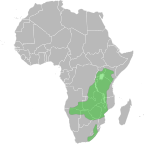
|
EN
|
| Black crowned crane | B. pavonina Linnaeus,1758 Two subspecies
|
Northern, central, and western Africa
|
VU
|
| Common name | Scientific name and subspecies | Range | IUCN status and estimated population |
|---|---|---|---|
| Siberian crane | L. leucogeranus (Pallas,1773) |
NorthwesternPalearcticand east-centralSiberia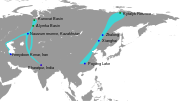
|
CR
|
| Common name | Scientific name and subspecies | Range | IUCN status and estimated population |
|---|---|---|---|
| Sandhill crane | A. canadensis (Linnaeus,1758)) Five subspecies
|
North America
|
LC
|
| White-naped crane | A. vipio (Pallas,1811) |
Southeastern Siberia, northeastern Mongolia and northeastern China
|
VU
|
| Sarus crane | A. antigone (Linnaeus,1758) Three subspecies
|
Northern India, Southeast Asia, and northern Australia
|
VU
|
| Brolga | A. rubicunda (Perry,1810) |
Australia and south-central New Guinea
|
LC
|
| Common name | Scientific name and subspecies | Range | IUCN status and estimated population |
|---|---|---|---|
| Wattled crane | G. carunculata[b] (Gmelin, J. F.,1789) |
Southern and eastern Africa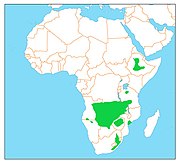
|
VU
|
| Blue crane | G. paradisea[c] (Lichtenstein, A. A. H.,1793) |
Southern Africa
|
VU
|
| Demoiselle crane | G. virgo[d] (Linnaeus,1758) |
Asia and northwestern Africa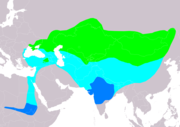
|
LC
|
| Red-crowned crane | G. japonensis (Müller, P. L. S.,1776) |
East Asia and Siberia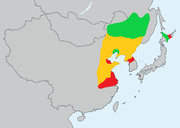
|
VU
|
| Whooping crane | G. americana (Linnaeus,1758) |
North America
|
EN
|
| Common crane | G. grus (Linnaeus,1758) |
Afro-Eurasia
|
LC
|
| Hooded crane | G. monacha Temminck,1835 |

|
VU
|
| Black-necked crane | G. nigricollis Przevalski,1876 |
India and China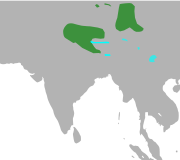
|
NT
|
Notes
[edit]- ^The IUCN follows the taxonomy proposed by theHBW and BirdLife Taxonomic Checklist.[10]
- ^The wattled crane is placed in the genusBugeranusby the IUCN and Clements Checklist.[10][17]
- ^The blue crane is placed in the genusAnthropoidesby the IUCN and Clements Checklist.[10][17]
- ^The Demoiselle crane is placed in the genusAnthropoidesby the IUCN and Clements Checklist.[10][17]
References
[edit]- ^abcdWinkler, David W.; Billerman, Shawn M.; Lovette, Irby J. (4 March 2020). Billerman, Shawn M.; Keeney, Brooke K.; Rodewald, Paul G.; Schulenberg, Thomas S. (eds.)."Cranes (Gruidae)".Birds of the World.Cornell Lab of Ornithology.doi:10.2173/bow.gruida1.01.Archivedfrom the original on 1 September 2023.Retrieved1 September2023.
- ^abGrimmett, Richard; Inskipp, Carol; Inskipp, Tim (2016).Birds of the Indian Subcontinent: India, Pakistan, Sri Lanka, Nepal, Bhutan, Bangladesh and the Maldives.London: Bloomsbury Publishing. p. 27.ISBN978-1-4081-6265-1.Archivedfrom the original on 19 September 2023.Retrieved15 September2023.
- ^Armistead, George L.; Sullivan, Brian L. (2015).Better Birding.Princeton:Princeton University Press.p. 71.ISBN9781400874163.
Herons usually fly with their necks retracted (coiled, unlike ibis, storks, and cranes) but occasionally extend their necks during shorter flights.
- ^abBirdLife International(2018)."Leucogeranus leucogeranus".IUCN Red List of Threatened Species.2018:e.T22692053A134180990.doi:10.2305/IUCN.UK.2018-2.RLTS.T22692053A134180990.en.Retrieved11 November2021.
- ^abBirdLife International(2020)."Grus americana".IUCN Red List of Threatened Species.2020:e.T22692156A181242855.doi:10.2305/IUCN.UK.2020-3.RLTS.T22692156A181242855.en.Retrieved13 November2021.
- ^abBirdLife International(2021)."Grus canadensis".IUCN Red List of Threatened Species.2021:e.T22692078A188597759.doi:10.2305/IUCN.UK.2021-3.RLTS.T22692078A188597759.en.Retrieved3 January2023.
- ^abcdGill, F.; Donsker, D.; Rasmussen, P., eds. (July 2023)."Finfoots, flufftails, rails, trumpeters, cranes, limpkin".IOC World Bird List.v 13.2.Archivedfrom the original on 24 April 2020.Retrieved31 August2023.
- ^Winkler, David W.; Billerman, Shawn M.; Lovette, Irby J. (4 March 2020). Billerman, Shawn M.; Keeney, Brooke K.; Rodewald, Paul G.; Schulenberg, Thomas S. (eds.)."Limpkin (Aramidae)".Birds of the World.Cornell Lab of Ornithology.doi:10.2173/bow.aramid1.01.S2CID241328872.Archivedfrom the original on 1 September 2023.Retrieved1 September2023.
- ^"Fossilworks: Gruidae".Paleobiology Database.University of Wisconsin–Madison.Archivedfrom the original on 18 May 2022.Retrieved1 September2023.
- ^abcd"Handbook of the Birds of the World and BirdLife International digital checklist of the birds of the world. Version 7".HBW and BirdLife International. 2022.Archivedfrom the original on 25 September 2019.Retrieved1 July2023.
- ^abNováková, Nela; Robovský, Jan (2021)."Behaviour of cranes (family Gruidae) mirrors their phylogenetic relationships".Avian Research.12(1).doi:10.1186/s40657-021-00275-4.ISSN2053-7166.
- ^BirdLife International(2016)."Balearica regulorum".IUCN Red List of Threatened Species.2016:e.T22692046A93334893.doi:10.2305/IUCN.UK.2016-3.RLTS.T22692046A93334893.en.Retrieved19 November2021.
- ^BirdLife International(2016)."Balearica pavonina".IUCN Red List of Threatened Species.2016:e.T22692039A93334339.doi:10.2305/IUCN.UK.2016-3.RLTS.T22692039A93334339.en.Retrieved18 November2021.
- ^BirdLife International(2018)."Grus vipio".IUCN Red List of Threatened Species.2018:e.T22692073A131927305.doi:10.2305/IUCN.UK.2018-2.RLTS.T22692073A131927305.en.Retrieved20 February2022.
- ^BirdLife International(2016)."Grus antigone".IUCN Red List of Threatened Species.2016:e.T22692064A93335364.doi:10.2305/IUCN.UK.2016-3.RLTS.T22692064A93335364.en.Retrieved20 February2022.
- ^BirdLife International(2016)."Grus rubicunda".IUCN Red List of Threatened Species.2016:e.T22692067A93335916.doi:10.2305/IUCN.UK.2016-3.RLTS.T22692067A93335916.en.Retrieved20 February2022.
- ^abcClements, James F.;Rasmussen, P. C.; Schulenberg, T. S.; Iliff, M. J.; Fredericks, T. A.; Gerbracht, J. A.; Lepage, Denis; Billerman, S. M.; Sullivan, B. L.; Wood, C. L. (2023)."The eBird/Clements checklist of Birds of the World: v2023".Clements Checklist.Archivedfrom the original on 1 January 2020.Retrieved30 October2023.
- ^BirdLife International(2018)."Bugeranus carunculatus".IUCN Red List of Threatened Species.2018:e.T22692129A129880815.doi:10.2305/IUCN.UK.2018-2.RLTS.T22692129A129880815.en.Retrieved20 February2022.
- ^BirdLife International(2021)."Anthropoides paradiseus".IUCN Red List of Threatened Species.2021:e.T22692109A177514877.doi:10.2305/IUCN.UK.2021-3.RLTS.T22692109A177514877.en.Retrieved20 February2022.
- ^BirdLife International(2018)."Anthropoides virgo".IUCN Red List of Threatened Species.2018:e.T22692081A131927771.doi:10.2305/IUCN.UK.2018-2.RLTS.T22692081A131927771.en.Retrieved14 February2022.
- ^BirdLife International(2022)."Grus japonensis".IUCN Red List of Threatened Species.2021:e.T22692167A213488064.Retrieved31 August2023.
- ^BirdLife International(2016)."Grus grus".IUCN Red List of Threatened Species.2016:e.T22692146A86219168.doi:10.2305/IUCN.UK.2016-3.RLTS.T22692146A86219168.en.Retrieved19 February2022.
- ^BirdLife International(2016)."Grus monacha".IUCN Red List of Threatened Species.2016:e.T22692151A93337861.doi:10.2305/IUCN.UK.2016-3.RLTS.T22692151A93337861.en.Retrieved18 November2021.
- ^BirdLife International(2020)."Grus nigricollis".IUCN Red List of Threatened Species.2020:e.T22692162A180030167.doi:10.2305/IUCN.UK.2020-3.RLTS.T22692162A180030167.en.Retrieved19 November2021.

